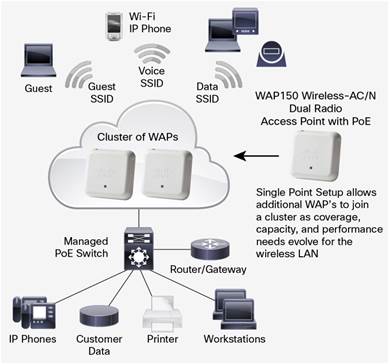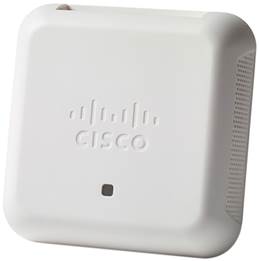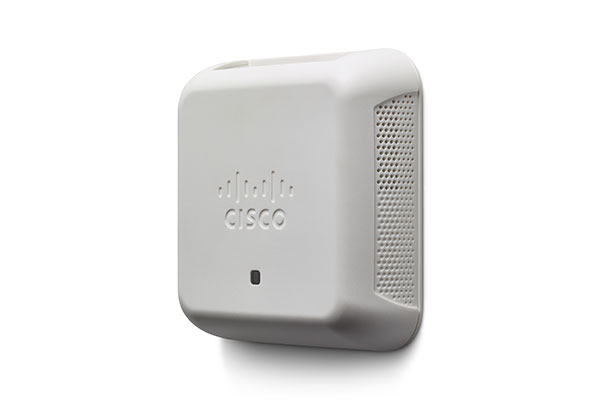Overview:
Highlights
- Provides cost-effective 802.11ac connectivity with speed up to 1.2 Gbps
- Gigabit Ethernet LAN interface with Power over Ethernet (PoE) can enable flexible installation
- A captive portal can enable highly secure guest access with customized roles and rights
- Single Point Setup requires no controller, for easy, cost-effective deployment of multiple access points
- Works right out of the box with easy installation and a simple web-based configuration and wizard
Product Overview
In today’s dynamic business environment, employees are becoming more mobile and collaborative than ever. To stay productive, they need dependable, business-class access to network applications throughout the office. Cisco® WAP150 Wireless-AC/N Dual Radio Access Points provide a simple, cost-effective way to extend more secure, high-performance mobile networking to your employees and guests, so they can stay connected anywhere in the office. This flexible solution lets you connect dozens of employees, and can scale to accommodate additional users and changing business needs.
The WAP150 access point uses concurrent dual-band radios for improved coverage on mobile devices. Gigabit Ethernet LAN interfaces with Power over Ethernet (PoE) support flexible installation and can reduce cabling and wiring costs. Intelligent quality-of-service (QoS) features let you prioritize bandwidth-sensitive traffic for voice over IP (VoIP) and video applications.
To provide highly secure guest access to visitors and other users, WAP150 access points support a captive portal with multiple authentication options and the ability to configure rights, roles, and bandwidth. A customized guest login page lets you present a welcome message and access details, and reinforces your brand with company logos.
The WAP150 Wireless-AC/N Dual Radio Access Point is easy to set up and use, with intuitive wizard-based configuration to get you up and running in minutes. An attractive design with flexible mounting options allows the access points to blend well into any small business environment.
To enhance reliability and safeguard sensitive business information, WAP150 access points support both Wi-Fi Protected Access (WPA) Personal and Enterprise, encoding all your wireless transmissions with powerful encryption. In addition, 802.1X RADIUS authentication helps keep unauthorized users out.
Designed to scale smoothly as your organization grows, the access point features controller-less Single Point Setup, which simplifies the deployment of multiple access points without additional hardware. With WAP150 access points, you can extend business-class wireless networking to employees and guests anywhere in the office, with the flexibility to meet new business needs for years to come.
Figure 1 shows a typical wireless access point configuration. Figures 2 and 3 show the product’s front and back panels, respectively.
Figure 1. Typical Wireless Access Point Configuration

Figure 2. Front Panel of a WAP150 Wireless-AC/N Dual Radio Access Point with PoE

Figure 3. Back Panel of a WAP150 Wireless-AC/N Dual Radio Access Point with PoE

Technical Specifications:
Table 1 lists the specifications, package contents, and minimum requirements for the WAP150 access point.
Table 1. Specifications for the WAP150 Access Point
| Specifications |
Description |
| Standards |
IEEE 802.11ac, 802.11n, 802.11g, 802.11b, 802.3af, 802.3u, 802.1X (security authentication), 802.1Q (VLAN), 802.1D (Spanning Tree), 802.11i (WPA2 security), 802.11e (wireless QoS), IPv4 (RFC 791), IPv6 (RFC 2460) |
| Ports |
LAN Gigabit Ethernet auto-sensing |
| Cabling type |
Category 5e or better |
| Antennas |
Internal antennas optimized for installation on a wall or ceiling |
| LED indicators |
1 multifunction LED |
| Operating system |
Linux |
| Ports |
10/100/1000 Ethernet, with support for 802.3af /at PoE, power port for AC adapter (included) |
| Buttons |
Reset button, power on/off push button |
| Lock slot |
Slot for Kensington lock |
| LEDs |
1 LED |
| Physical dimensions (W x D x H) |
5.31 x 5.31x 1.5 in. (135 x 135 x 38 mm) |
| Weight |
0.77lb or 350g |
| VLAN support |
Yes |
| Number of VLANs |
1 management VLAN plus 8 VLANs for SSIDs |
| 802.1X supplicant |
Yes |
| SSID-to-VLAN mapping |
Yes |
| Auto-channel selection |
Yes |
| Spanning tree |
Yes |
| Load balancing |
Yes |
| IPv6 |
- Yes
- IPv6 host support
- IPv6 RADIUS, syslog, Network Time Protocol (NTP)
|
| Layer 2 |
802.1Q-based VLANS, 8 active VLANs plus 1 management VLAN |
| WPA, WPA2 |
Yes, including Enterprise authentication |
| Access control |
Yes, management access control list (ACL) plus MAC ACL |
| Secure management |
HTTPS |
| SSID broadcast |
Yes |
| Rogue access point detection |
Yes |
| Multiple mounting options |
Desktop or Wall |
| Physical security lock |
Kensington lock slot |
| QoS |
Wi-Fi Multimedia and Traffic Specification (WMM TSPEC), client QoS |
| Wireless throughput |
Up to 1.2 Gbps data rate (real-world throughput will vary) |
| Recommended user support |
Up to 64 connective users, 10 active users per radio |
| Single Point Setup |
Yes |
| Number of access points per cluster |
4 |
| Active clients per cluster |
120 |
| Web user interface |
Built-in web user interface for easy browser-based configuration (HTTP, HTTPS) |
| Management protocols |
Web browser, Simple Network Management Protocol (SNMP) v3, Bonjour |
| Remote management |
Yes |
| Event logging |
Local, remote syslog, email alerts |
| Network diagnostics |
Logging and packet capture |
| Web firmware upgrade |
Firmware upgradable through web browser, imported or exported configuration file |
| Dynamic Host Configuration Protocol (DHCP) |
DHCP client |
| IPv6 host |
Yes |
| HTTP redirect |
Yes |
| Frequency |
Dual concurrent radios (2.4 and 5 GHz) |
| Radio and modulation type |
Dual radio, orthogonal frequency division multiplexing (OFDM) |
| WLAN |
802.11n/ac
2x2 multiple-input multiple-output (MIMO) with 2 spatial streams at 5 GHz
2x2 MIMO with 2 spatial streams at 2.4 GHz
20-, 40-, and 80-Mhz channels for 802.11ac
20- and 40-Mhz for 802.11n
PHY data rate up to 1.2 Gbps
802.11 dynamic frequency selection (DFS) |
| Data rates supported |
802.11a/b/g:
- 54, 48, 36, 24, 18, 12, 9, 6, 11, 5.5, 2, and 1 Mbps
- 802.11n: 6.5 to 300 Mbps
◦ 20-MHz bandwidth: MCS 0-15 for supported data rates
◦ 40-MHz bandwidth: MCS 0-15 for supported data rates
- 802.11ac: 6.5 to 867 Mbps
◦ 20-MHz bandwidth: MCS 0-9 for supported data rates
◦ 40-MHz bandwidth: MCS 0-9 for supported data rates
◦ 80-MHz bandwidth: MCS 0-9 for supported data rates
|
| Frequency band and operating channels |
A/B Regulatory Domain
- 2.412 to 2.462 GHz; 11 channels
- 5.180 to 5.240 GHz; 4 channels
- 5.260 to 5.320 GHz; 4 channels
- 5.500 to 5.700 GHz; 8 channels
- 5.745 to 5.825 GHz; 5 channels
E Regulatory Domain:
- 2.412 to 2.472 GHz; 13 channels
- 5.180 to 5.240 GHz; 4 channels
- 5.260 to 5.320 GHz; 4 channels
- 5.500 to 5.700 GHz; 8 channels
|
C Regulatory Domain:
- 2.412 to 2.462 GHz; 11 channels
- 5.180 to 5.240 GHz; 4 channels
- 5.260 to 5.320 GHz; 4 channels
- 5.745 to 5.825 GHz; 5 channels
K Regulatory Domain:
- 2.412 to 2.472 GHz; 13 channels
- 5.180 to 5.240 GHz; 4 channels
- 5.260 to 5.320 GHz; 4 channels
- 5.500 to 5.620 GHz; 7 channels
- 5.745 to 5.805 GHz; 4 channels
|
| Non-overlapping channels |
2.4 GHz
- 802.11b/g
◦ 20 MHz: 3
- 802.11n
◦ 20 MHz: 3
5 GHz
- 802.11a
◦ 20 MHz: 21
- 802.11n
◦ 20 MHz: 21
◦ 40 MHz: 9
- 802.11ac
◦ 20 MHz: 21
◦ 40 MHz: 9
◦ 80 MHz: 4
|
| Wireless isolation |
Wireless isolation between clients |
| External antennas |
None |
| Internal antennas |
Internal Fixed Planar inverted-F antenna (PIFA) |
| Antenna gain in dBi |
Maximum antenna gain of 3.61 dBi on 2.4 GHz
Maximum antenna gain of 3.85 dBi on 5 GHz |
| Wireless distribution system (WDS) |
Yes |
| Fast roaming |
Yes |
| Multiple SSIDs |
8 |
| Wireless VLAN map |
Yes |
| WLAN security |
Yes |
| Wi-Fi Multimedia (WMM) |
Yes, with unscheduled automatic power save |
| Access point |
Access point mode, WDS Bridging, Workgroup Bridge mode |
| Power options |
IEEE 802.3af Ethernet switch
Cisco Power Injector - SB-PWR-INJ2-xx
AC adapter – SB-PWR-12V/1.5A power adapter in a box
POE power
Peak power: 9.5Watts |
| Compliance |
Safety:
- UL 60950-1
- CAN/CSA-C22.2 No. 60950-1
- IEC 60950-1
- EN 60950-1
Radio approvals:
- FCC Part 15.247, 15.407
- RSS-210 (Canada)
- EN 300.328, EN 301.893 (Europe)
- AS/NZS 4268.2003 (Australia and New Zealand)
EMI and susceptibility (Class B):
- FCC Part 15.107 and 15.109
- ICES-003 (Canada)
- EN 301.489-1 and -17 (Europe)
|
| Operating temperature |
0° to 40°C (32° to 104°F) |
| Storage temperature |
-20° to 70°C (-4° to 158°F) |
| Operating humidity |
10% to 85% noncondensing |
| Storage humidity |
5% to 90% noncondensing |
| System memory |
256 MB RAM
128 MB flash |
- WAP150 Wireless-AC/N Dual Radio Access Point
- Power adapter 12V1.5A
- Quick-start guide
- Ethernet network cable
|
- Switch or router with PoE support, PoE injector, or AC power adapter
- Web-based configuration: Java-enabled web browser
|
| Access point |
Limited lifetime |
Table 2. Cisco WAP150 Wireless-AC/N Access Point RF Performance Table
| 1 Mbps |
16.0 +/- 1.5 |
-98.0 |
| 11 Mbps |
16.0 +/- 1.5 |
-90.0 |
| 6 Mbps |
14.0 +/- 1.5 |
-90.0 |
| 54 Mbps |
14.0 +/- 1.5 |
-75.0 |
| |
14.0 +/- 1.5 |
-90.0 |
| MCS7/15 |
14.0 +/- 1.5 |
-74.0 |
| MCS0/8 |
13.0 +/- 1.5 |
-88.0 |
| MCS7/15 |
13.0 +/- 1.5 |
-71.0 |
| 6 Mbps |
16.0 +/- 1.5 |
-91.0 |
| 54 Mbps |
16.0 +/- 1.5 |
-77.0 |
| MCS0/8 |
15.0 +/- 1.5 |
-91.0 |
| MCS7/15 |
15.0 +/- 1.5 |
-74.0 |
| MCS0/8 |
15.0 +/- 1.5 |
-87.0 |
| MCS7/15 |
15.0 +/- 1.5 |
-71.0 |
| 5GHz – 802.11ac HT20 |
| MCS0 |
14.0 +/- 1.5 |
-91.0 |
| MCS8 |
14.0 +/- 1.5 |
-69.0 |
| 5GHz – 802.11ac HT40 |
| MCS0 |
14.0 +/- 1.5 |
-87.0 |
| MCS9 |
14.0 +/- 1.5 |
-64.0 |
| 5GHz – 802.11ac HT80 |
| MCS0 |
14.0 +/- 1.5 |
-88.0 |
| MCS9 |
14.0 +/- 1.5 |
-61.0 |
Note: This table shows the maximum capability of the hardware. The transmit power may be reduced to comply with local regulatory requirements.
Documentation:
Download the Cisco WAP150 Datasheet (PDF).






